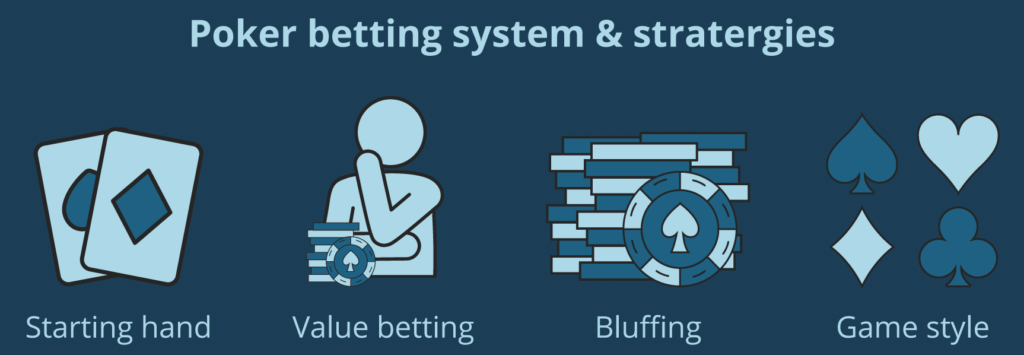Master the Rules of Poker
With so many variations of poker It may seem complicated with the various options available, but at its core, most poker variations share four fundamental principles;
- Hand Ranking – The player with the strongest hand takes the win.
- Bluffing – Achieving victory without possessing the best hand.
- Betting – A wager of some form is always mandated.
- Dealer – An active dealer is necessary, regardless of player status.

The Objective
The ultimate aim in any poker game is to defeat your competitors and, in real-money betting scenarios, to secure the pot and complete the game with a greater stack than you began with . Depending on the setting, a poker game may stretch from mere minutes to several hours or even days.
Poker Hand Rules
- Royal Flush – A five-card hand consisting of 10 to Ace in one suit.
- Straight Flush – A consecutive five-card hand in the same suit. A higher Straight Flush can beat it.
- Four of a Kind – A set of identical cards from all four suits.
- Full House – A combination of three cards of one rank and an additional pair. In competitions between Full Houses, the higher three of a Kind prevails.
- Flush – A five-card hand all in the same suit, regardless of their order. The Flush with the highest card surpasses others.
- Straight – A five-card hand that comprises sequential values and can include multiple suits.
- Three of a Kind – A hand featuring three matching cards, supported by the two higher-ranked available cards.
- Two Pairs – Comprising two sets of matching cards, backed by the highest single card in play.
- Pair – A duo of cards of the same rank, complemented by the highest three available cards.
- High Card – The top card in a five-card hand, usually regarded as the weakest type of hand in poker.
Poker games don’t all assess hand value through the same methods. Poker Hand rules diverge; for example, High-Hand Poker adheres to the ranking hierarchy above. Meanwhile, Low-Hand Poker essentially flips traditional hand values and may introduce alternate ranking systems. Hi-Low Poker frequently divides pots between the highest and lowest hands .
Pre-Flop, Flop, Turn, River, Showdown

In the most popular poker games like Texas Hold’Em poker plays progress step by step, with the dealer following a particular sequence known as the Flop, Turn, and River . Players can place bets before and after each step.
Pre-Flop
During the initial phase of the Poker Game, prior to dealing the first three community cards, players are each dealt two cards, referred to as Hole Cards.
Flop
The Flop consists of three community cards dealt face-up on the table. They are called ‘community cards’ because all players can utilize them to form a winning hand.
Turn
After placing bets post-Flop, the dealer lays down a fourth face-up card known as the Turn.
River
The River refers to the fifth and final community card revealed face-up by the dealer. After betting on the Turn, players are presented with this card, providing a final chance to improve their hands.
Showdown
The last phase, known as Showdown, occurs when the top-ranking hand claims victory and takes the total pot.
Dealer Button
The Dealer Button is a marker, chip, or another item indicating which player is the ‘Dealer’ for that round. Typically, the Dealer Button shifts clockwise one position with each hand dealt. Its key significance lies in determining which player has the advantage of betting last , a notable edge in poker.
Big and Small Blinds
The Big Blind and Small Blind are player positions adjacent to the dealer. The Small Blind sits next to the dealer, and the Big Blind is beside the Small Blind – two positions away from the dealer. These positions must place mandatory bets .
In most cases, the Big Blind will bet the minimum required by the table , while the Small Blind bets half that amount . These mandatory bets serve to create a minimum pot for the round and encourage players not to fold automatically.
An explanation of No Limit, Pot Limit, and Fixed Limit
When it comes to poker, every variation specifies the pot type being contested and the applicable Poker betting regulations.
- No Limit is the favored method of playing poker, with Texas Hold ‘Em usually being played without limits. In a No Limit game, players have the freedom to wager any amount during each round, essentially inflating the pot size significantly. The potential for large bets can be used tactically, adding considerable thrill to the game.
- Pot Limit applies when there is a maximum limit on bets based on the total amount in the pot, including contributions from other players. A player with a large stack cannot go ‘All In’ but can still dramatically increase the pot’s value in one hand. Strategies for Pot Limit games vary significantly from those used in No Limit games.
- Limit or Fixed Limit poker games are regarded as the most challenging to play due to the constraints on betting amounts that have been agreed upon in advance. Players may only wager the specific amounts established. Fixed Limit poker games are the least common and require continuous calculations of poker odds.
Rule Variations
For the majority of players, Texas Hold ‘Em is synonymous with poker; although it is the most highly played variant , it’s merely one among several. Many poker forms can be classified as either Draw Poker, Stud Poker, or Community Card Poker , with Texas Hold ‘Em being one type.
While the foundational poker rules generally apply across all games, players might encounter variations regarding dealing techniques, hand rankings, and/or betting methods.
- Draw poker keeps all cards hidden
- Low-Ball poker effectively reverses the Hand Ranking values - the lowest hand is the winner.
- A poker game can operate under No Limit, Pot Limit, or Fixed Limit , each featuring its unique betting standards.
- Certain poker variants may incorporate wild cards and establish specific game rules.
- Poker games may also be classified by table size and the maximum number of participating players allowed.
You can even tie in poker, which may catch some players off guard. Our video guide below clearly explains what actions to take if you find yourself in such a situation at the poker table.
Types of bets in Poker
Mastering Poker Success is about mastering your betting game . Poker wagers represent the intersection of player psychology and strategy, as each bet comes with its motivation – be it to provoke a challenge or instill fear, to inflate the pot, or ultimately to secure a win.
Out of the Nine essential bets critical to poker, the Top Six are value bets, continuation bets, tactical slow plays, overbets, all-in bets, and pot bets . The judicious selection and use of these bets form the foundation of a solid poker strategy.
Poker odds and payouts
| Odds | Flop to Turn | Turn To River | Turn & River |
|---|---|---|---|
| 20 | 1.35:1 | 1.30:1 | 0.48:1 |
| 19 | 1.47:1 | 1.42:1 | 0.54:1 |
| 18 | 1.61:1 | 1.56:1 | 0.60:1 |
| 17 | 1.77:1 | 1.71:1 | 0.67:1 |
| 16 | 1.94:1 | 1.88:1 | 0.75:1 |
| 15 | 2.13:1 | 2.07:1 | 0.85:1 |
| 14 | 2.36:1 | 2.29:1 | 0.95:1 |
| 13 | 2.62:1 | 2.54:1 | 1.08:1 |
| 12 | 2.92:1 | 2.83:1 | 1.22: 1 |
| 11 | 3.27:1 | 3.18:1 | 1.40:1 |
| 10 | 3.70:1 | 3.60:1 | 1.60:1 |
| 9 | 4.22:1 | 4.11:1 | 1.86:1 |
| 8 | 4.88:1 | 4.75:1 | 2.17:1 |
| 7 | 5.71:1 | 5.57:1 | 2.60:1 |
| 6 | 6.83:1 | 6.67:1 | 3.15:1 |
| 5 | 8.40:1 | 8.20:1 | 3.93:1 |
| 4 | 10.75:1 | 10.50:1 | 5.06:1 |
| 3 | 14.67:1 | 14.33:1 | 7.00:1 |
| 2 | 22.50:1 | 22.00:1 | 10.90:1 |
| 1 | 46.00:1 | 45.00:1 | 22.26:1 |
House Edge in Poker
When evaluating poker odds, players participating in a land-based or online game should always keep in mind the presence of the House Edge.
The House Edge denotes the statistical advantage the casino maintains over players regarding overall winnings. The House Edge in most poker variants remains relatively low, from 5.22% for Caribbean Stud Poker (the highest), 2.19% for Ultimate Texas Hold ‘Em , and a low 0.46% for Video Poker .
Understanding Poker Play – A Round Deconstructed
A guided walkthrough through a round of Texas Hold ‘Em…
- The Dealer is appointed and distributes two cards to every player seated at the table
- The player who sits directly to the left of the dealer places a wager in the pot – this player is referred to as the Small Blind
- The player situated two seats to the left of the dealer places a wager in the pot, known as the Big Blind .
- As the betting progresses in a clockwise direction, the other participants place their bets depending on how confident they feel about their two hole cards.
- The Dealer reveals the Flop, consisting of three community cards that are placed face-up on the table .
- The second betting round kicks off, starting from the position of the dealer and proceeding clockwise around the table.
- Next, the Dealer lays out the Turn, which is the fourth community card displayed face up .
- The third betting round follows, continuing in a clockwise fashion starting from the dealer's position.
- The Dealer presents the River, which is the fifth and final community card shown face-up .
- The final betting round starts, again moving in a clockwise direction from the dealer.
- If there are two or more players left in the hand after the betting phase concludes, it's time to reveal the hands.
- The player with the highest-ranking hand takes the pot, collecting all the bets made.
Conclusion
Poker enjoys widespread popularity, and while the rules may seem straightforward, the various forms and adaptations can complicate the learning process. Once you grasp the various betting styles, odds, and payouts involved in Poker, you can confidently make decisions and start wagering real money.
You can visit our list the best online casinos in Canada These variations include a diverse range of Poker types along with numerous betting options appealing to all kinds of casino enthusiasts.







